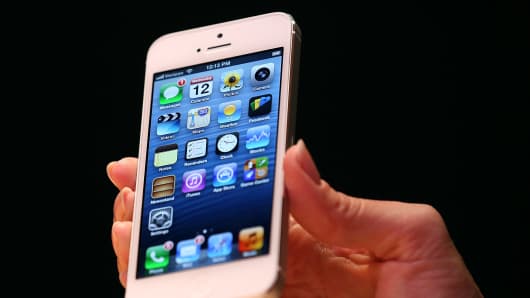As BlackBerry launches the first smartphone from its make-or-break BB10 line in India, one of its most loyal markets, the company faces new competition from a formidable rival that has long had a minimal presence in the country.
More than four years after it started selling iPhones in India, Apple is now aggressively pushing the iconic device through installment payment plans that make it more affordable, a new distribution model and heavy marketing blitz.
(Read More: Can a Rimless Blackberry Avoid Extinction?)
"Now your dream phone" at 5,056 rupees ($93), read a recentfull front-page ad for an iPhone 5 in the Times of India,referring to the initial payment on a phone priced at $840, oralmost two months' wages for an entry-level software engineer.
The new-found interest in India suggests a subtle strategyshift for Apple, which has moved tentatively in emerging marketsand has allowed rivals such as Samsung and Blackberry todominate with more affordable smartphones. With the exception ofChina, all of its Apple stores are in advanced economies.
Apple expanded its India sales effort in the latter half of2012 by adding two distributors. Previously it sold iPhones onlythrough a few carriers and stores it calls premium resellers.
The result: iPhone shipments to India between October andDecember nearly tripled to 250,000 units from 90,000 in theprevious quarter, according to an estimate by Jessica Kwee, aSingapore-based analyst at consultancy Canalys.
At The MobileStore, an Indian chain owned by the Essarconglomerate, which says it sells 15 percent of iPhones in thecountry, iPhone sales tripled between December and January,thanks to a monthly payment scheme launched last month.
"Most people in India can't afford a dollar-priced phonewhen the salaries in India are rupee salaries. But the desire isthe same," said Himanshu Chakrawarti, its chief executive.
Apple, the distributors, retailers and banks share theadvertising and interest cost of the marketing push, accordingto Chakrawarti. Carriers like Bharti Airtel Ltd , whichalso sell the iPhone 5, run separate ads.
India is the world's No. 2 cellphone market by users, butmost Indians can't afford fancy handsets. Smartphones accountfor just a tenth of total phone sales. In India, 95 percent ofcellphone users have prepaid accounts without a fixed contract.Unlike in the United States, carriers do not subsidize handsets.
Within the smartphone segment, Apple's Indian market sharelast quarter was just 5 percent, according to Canalys, meaningits overall penetration is tiny.
Still, industry research firm IDC expects the Indiansmartphone market to grow more than five times from about 19million units last year to 108 million in 2016, which presents abig opportunity.
(Read More: All the Reasons Blackberry 10 Will Fail: Analyst)
Samsung Electronics dominates Indian smartphonesales with a 40 percent share, thanks to its wide portfolio ofAndroid devices priced as low as $110. The market has also beenflooded by cheaper Android phones from local brands such asMicromax and Lava.
Most smartphones sold in India are much cheaper than theiPhone, said Gartner analyst Anshul Gupta.
"Where the masses are - there, Apple still has a gap." 'I LOVE INDIA, BUT...'
Apple helped create the smartphone industry with the iPhonein 2007, but last year lost its lead globally to Samsung whosefree Android software is especially attractive in Asia.
Many in Silicon Valley and Wall Street believe the surestway to penetrate lower-income Asian markets would be with acheaper iPhone, as has been widely reported but never confirmed.The risk is that a cheap iPhone would cannibalise demand for thepremium version and eat into Apple's peerless margins.
The new monthly payment plan in India goes a long way toexpanding the potential market, said Chakrawarti.
"The Apple campaign is not meant for really the regulartop-end customer, it is meant to upgrade the 10,000-12,000handset guy to 45,000 rupees," he said.
Apple's main focus for expansion in Asia has been GreaterChina, including Taiwan and Hong Kong, where revenue grew 60percent last quarter to $7.3 billion.
Asked last year why Apple had not been as successful inIndia, Chief Executive Tim Cook said its business in India wasgrowing but the group remained more focused on other markets.
"I love India, but I believe that Apple has some higherpotential in the intermediate term in some other countries,"Cook said. "The multi-layer distribution there really adds tothe cost of getting products to market," he said at the time.
Apple, which has partly addressed that by addingdistributors, did not respond to an email seeking comment.
(Read More: What's Apple's Most Pressing Issue?)
Ingram Micro Inc, one of its new distributors, alsodeclined comment. Executives at Redington (India) Ltd ,the other distributor, could not immediately be reached.
BlackBerry, which has seen its global market share shrivelto 3.4 percent from 20 percent over the past three years, ismaking what is seen as a last-ditch effort to save itself withthe BB10 series.
The high-end BlackBerry Z10 to be launched in India onMonday is expected to be priced not far from the 45,500 rupeesprice tag for an iPhone 5 with 16 gigabytes of memory. Samsung'sGalaxy S3 and Galaxy Note 2, Nokia's Lumia 920 andtwo HTC Corp models are the main iPhone rivals.
Until last year, Blackberry was the No. 3 smartphone brandin India with market share of more than 10 percent, thanks to apush into the consumer segment with lower-priced phones. Lastquarter its share fell to about 5 percent, putting it in fifthplace, according to Canalys. Apple was sixth.


